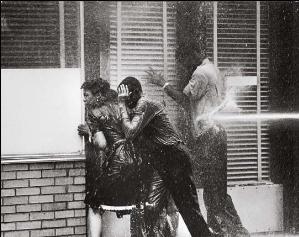Related Research Articles

The civil rights movement was a nonviolent social movement and campaign from 1954 to 1968 in the United States to abolish legalized racial segregation, discrimination, and disenfranchisement in the country. The movement had its origins in the Reconstruction era during the late 19th century and had its modern roots in the 1940s, although the movement made its largest legislative gains in the 1960s after years of direct actions and grassroots protests. The social movement's major nonviolent resistance and civil disobedience campaigns eventually secured new protections in federal law for the civil rights of all Americans.
Brown v. Board of Education of Topeka, 347 U.S. 483 (1954), was a landmark decision by the U.S. Supreme Court which ruled that U.S. state laws establishing racial segregation in public schools are unconstitutional, even if the segregated schools are otherwise equal in quality. The decision partially overruled the Court's 1896 decision Plessy v. Ferguson, which had held that racial segregation laws did not violate the U.S. Constitution as long as the facilities for each race were equal in quality, a doctrine that had come to be known as "separate but equal". The Court's decision in Brown paved the way for integration and was a major victory of the civil rights movement, and a model for many future impact litigation cases.

Chester is a city in Delaware County, Pennsylvania, United States. It is located in the Delaware Valley on the western bank of the Delaware River between Philadelphia and Wilmington, Delaware. The population of Chester was 32,605 at the 2020 census.

Race-integration busing in the United States was the practice of assigning and transporting students to schools within or outside their local school districts in an effort to diversify the racial make-up of schools. While the 1954 U.S. Supreme Court landmark decision in Brown v. Board of Education declared racial segregation in public schools unconstitutional, many American schools continued to remain largely uni-racial due to housing inequality. In an effort to address the ongoing de facto segregation in schools, the 1971 Supreme Court decision, Swann v. Charlotte-Mecklenburg Board of Education, ruled that the federal courts could use busing as a further integration tool to achieve racial balance.

The Southern Christian Leadership Conference (SCLC) is an African-American civil rights organization based in Atlanta, Georgia. SCLC is closely associated with its first president, Martin Luther King Jr., who had a large role in the American civil rights movement.
This is a timeline of African-American history, the part of history that deals with African Americans.

The Birmingham campaign, also known as the Birmingham movement or Birmingham confrontation, was an American movement organized in early 1963 by the Southern Christian Leadership Conference (SCLC) to bring attention to the integration efforts of African Americans in Birmingham, Alabama.

Allen Cavett Thompson was an American politician in the state of Mississippi. Affiliated with the Democratic Party, he served in the Mississippi House of Representatives and as mayor of Jackson, Mississippi.

The Chester Upland School District (CUSD) is a midsized, urban public school district serving the City of Chester, the Borough of Upland and Chester Township in Delaware County, Pennsylvania. The Chester-Upland School District administrative offices, which are no longer headquartered on the first floor of Chester High School, but have moved to a new location at 1350 Edgemont Avenue, encompasses approximately 5 square miles (13 km2).

Clara Shepard Luper was a civic leader, schoolteacher, and pioneering leader in the American Civil Rights Movement. She is best known for her leadership role in the 1958 Oklahoma City sit-in movement, as she, her young son and daughter, and numerous young members of the NAACP Youth Council successfully conducted carefully planned nonviolent sit-in protests of downtown drugstore lunch-counters, which overturned their policies of segregation. The success of this sit-in would result in Luper becoming a leader of various sit-ins throughout Oklahoma City between 1958 and 1964. The Clara Luper Corridor is a streetscape and civic beautification project from the Oklahoma Capitol area east to northeast Oklahoma City. In 1972, Clara Luper was an Oklahoma candidate for election to the United States Senate. When asked by the press if she, a black woman, could represent white people, she responded: “Of course, I can represent white people, black people, red people, yellow people, brown people, and polka dot people. You see, I have lived long enough to know that people are people.”
James Henry Gorbey was an American politician and judge from Pennsylvania. He was a Republican member of the Chester City Council from 1956 to 1963 and served as mayor of Chester, Pennsylvania, from 1964 to 1967 during the Chester school protests. Gorbey was a judge of the Delaware County Court of Common Pleas from 1968 to 1970 and a United States district judge of the United States District Court for the Eastern District of Pennsylvania from 1970 to 1977.

Golden Asro Frinks was an American civil rights activist and a Southern Christian Leadership Conference (SCLC) field secretary who represented the New Bern, North Carolina SCLC chapter. He is best known as a principal civil rights organizer in North Carolina during the 1960s.
Morgan v. Hennigan was the case that defined the school busing controversy in Boston, Massachusetts during the 1970s. On March 14, 1972, the Boston chapter of the NAACP filed a class action lawsuit against the Boston School Committee on behalf of 14 black parents and 44 children. Tallulah Morgan headed the list of plaintiffs, and James Hennigan, then chair of the School Committee, was listed as the main defendant.

The Biloxi wade-ins were three protests that were conducted by local African Americans on the beaches of Biloxi, Mississippi between 1959 and 1963, during the civil rights movement. The demonstrations were led by Dr. Gilbert R. Mason, Sr. in an effort to desegregate the city's 26 mi (42 km) of beaches on the Mississippi Gulf Coast. This was a local effort, without involvement from the state or national NAACP.

In the United States, school integration is the process of ending race-based segregation within American public and private schools. Racial segregation in schools existed throughout most of American history and remains an issue in contemporary education. During the Civil Rights Movement school integration became a priority, but since then de facto segregation has again become prevalent.
This is a timeline of the civil rights movement in the United States, a nonviolent mid-20th century freedom movement to gain legal equality and the enforcement of constitutional rights for people of color. The goals of the movement included securing equal protection under the law, ending legally institutionalized racial discrimination, and gaining equal access to public facilities, education reform, fair housing, and the ability to vote.
George T. Raymond was an American civil rights leader from Pennsylvania who served as president of the Chester, Pennsylvania, branch of the National Association for the Advancement of Colored People (NAACP) from 1942 to 1977. He was integral in the desegregation of businesses, public housing and schools in Chester and co-led the Chester school protests in 1964 which made Chester a key battleground in the civil rights movement.
Stanley Everett Branche was an American civil rights leader from Pennsylvania who worked as executive secretary in the Chester, Pennsylvania branch of the National Association for the Advancement of Colored People (NAACP) and founded the Committee for Freedom Now (CFFN).

The New York City school boycott, also referred to as Freedom Day, was a large-scale boycott and protest against segregation in the New York City public school system which took place on February 3, 1964. Students and teachers walked out to highlight the deplorable conditions at public schools in the city, and demonstrators held rallies demanding school integration. It has been described as the largest civil rights protest of the 1960s, involving nearly half a million participants.
The Committee for Freedom Now (CFFN) was an American civil rights organization in Chester, Pennsylvania, that worked to end de facto segregation and improve the conditions at predominantly black schools in Chester. CFFN was founded in 1963 by Stanley Branche along with the Swarthmore College chapter of Students for a Democratic Society and Chester parents. From November 1963 to April 1964, CFFN and the Chester chapter of the NAACP, led by George Raymond, initiated the Chester school protests which made Chester a key battleground in the civil rights movement.
References
Citations
- ↑ Mele 2017, pp. 84–85.
- 1 2 3 4 Mele 2017, p. 94.
- 1 2 3 4 5 6 7 8 9 10 11 12 13 14 15 "African American residents of Chester, PA, demonstrate to end de facto segregation in public schools, 1963-1966". www.nvdatabase.swarthmore.edu. Retrieved October 26, 2018.
- 1 2 Mele 2017, p. 95.
- ↑ McLarnon 2002, pp. 318–326.
- ↑ Mele 2017, pp. 76–77.
- ↑ Mele 2017, p. 83.
- ↑ Holcomb, Lindsay (October 29, 2015). "Questions surround student activism 52 years later". www.swarthmorephoenix.com. Retrieved October 25, 2018.
- ↑ McLarnon 2002, p. 305.
- ↑ Mele 2017, p. 50.
- ↑ McLarnon 2002, p. 307.
- ↑ Mele 2017, pp. 82–83.
- ↑ Mele 2017, p. 84.
- ↑ Hogan, Wesley C. (2007). Many Minds, One Heart: SNCC's Dream for a New America. Chapel Hill: The University of North Carolina Press. pp. 131–132. ISBN 978-0-8078-3074-1 . Retrieved March 16, 2020.
- ↑ Mele 2017, pp. 88–93.
- ↑ Hogan, Wesley C. (2007). Many Minds, One Heart: SNCC's Dream for a New America. Chapel Hill: The University of North Carolina Press. p. 129. ISBN 978-0-8078-3074-1 . Retrieved March 8, 2020.
- ↑ McLarnon 2002, p. 318.
- ↑ "Chester NAACP Scrapbook 1963-1964". www.digitalwolfgram.widener.edu. Retrieved October 20, 2018.
- ↑ "RIOTS MAR PEACE IN CHESTER, PA.; Negro Protests Continue - School Policy at Issue". The New York Times. April 26, 1964. Retrieved July 13, 2018.
- ↑ Congressional Record: Proceedings and Debate of the 88th Congress Second Session - Volume 110 - Part 7. Washington: United States Government Printing Office. 1964. p. 8883. Retrieved March 8, 2020.
- ↑ McLarnon 2003, p. 234.
- ↑ Mele 2017, pp. 94–95.
- ↑ "Birmingham Civil Rights". National Park Service. Retrieved March 3, 2020.
- ↑ McLarnon 2002, pp. 325–326.
- ↑ Mele 2017, p. 96.
- ↑ McLarnon 2002, p. 335.
Sources
- McLarnon, John Morrison (2002). ""Old Scratchhead" Reconsidered: George Raymond & Civil Rights in Chester, Pennsylvania". Pennsylvania History. 69 (3): 297–341.
- McLarnon, John Morrison (2003). Ruling Suburbia: John J. McClure and the Republican Machine in Delaware County, Pennsylvania. University of Delaware Press. ISBN 0-87413-814-0.
- Mele, Christopher (2017). Race and the Politics of Deception: The Making of an American City. New York University Press. ISBN 978-1-4798-6609-0.
- Sigmond, Carl E. (August 29, 2011). "African American residents of Chester, PA, demonstrate to end de facto segregation in public schools, 1963-1966" . Retrieved July 13, 2018.